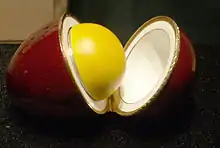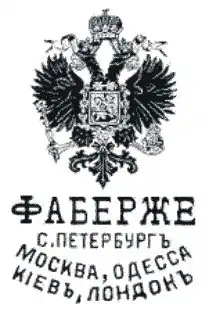Scandinavian (Fabergé egg)
The Scandinavian egg is an enamelled Easter egg made by Michael Perchin under the supervision of the Russian jeweller Peter Carl Fabergé between 1899 and 1903.[1] The egg was made for a St. Petersburg client, one of the very few eggs that were not made for the Russian Imperial Family.[1]
| Scandinavian Fabergé egg | |
|---|---|
 | |
| Year delivered | 1899–1903 |
| Customer | Unknown St. Petersburg client |
| Current owner | |
| Individual or institution | Viktor Vekselberg Fabergé Museum in Saint Petersburg, Russia |
| Year of acquisition | 2004 |
| Design and materials | |
| Workmaster | Michael Perkhin |
| Materials used | Gold, translucent strawberry red enamel, diamonds |
| Height | 74 millimetres (2.9 in) |
| Surprise | The egg opens to reveal an enamelled yolk, which contains a miniature hen. |
Design
The egg opens to reveal an enamelled yolk, which contains a miniature hen.[2]
History
Rediscovered in an Oslo bank safe, among the possessions of Maria Quisling, the widow of World War II fascist collaborator Vidkun Quisling,[3] it was acquired by Malcolm Forbes for his Fabergé collection in the 1980s.
The Forbes Collection was sold in 2004 to Viktor Vekselberg for almost $100 million.[4]
See also
References
- "Faberge - Treasures of Imperial Russia". Archived from the original on 2007-08-23. Retrieved 2007-11-30.
- "Faberge - Treasures of Imperial Russia". Archived from the original on 2007-05-15. Retrieved 2007-11-30.
- "Mieks Fabergé Eggs". Archived from the original on 2005-05-30. Retrieved 2019-10-07.
- Energy Tribune Archived 2014-06-06 at the Wayback Machine
External links
- A detailed article on the "Scandinavian" egg, from imperialtresuresofrussia.com
- A detailed article on the "Scandinavian" egg, from Mieks Fabergé Eggs
| Wikimedia Commons has media related to Scandinavian (Fabergé egg). |
This article is issued from Wikipedia. The text is licensed under Creative Commons - Attribution - Sharealike. Additional terms may apply for the media files.
